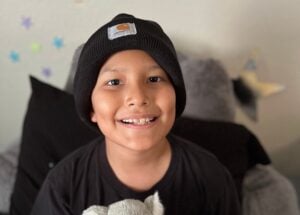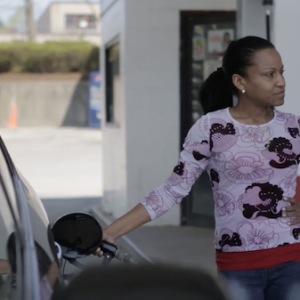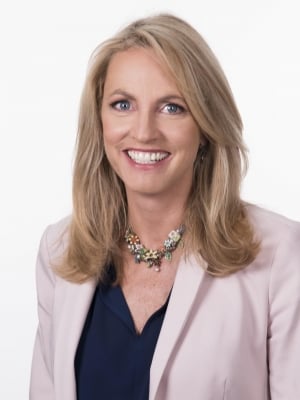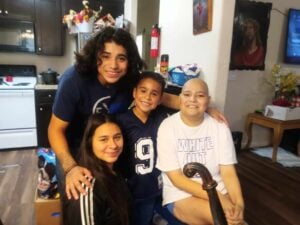
Sights Set on a Strong End to 2023 — Will You Join Us?
Family Reach CEO Carla Tardif reflects on 2023 and calls for community support before the year ends.
Photo: Sue Ellen, single mom and caregiver to Giraldy

Science is far outpacing the cancer patient experience.
There are 17 million people in the US living with cancer1 — yet the science simply doesn’t apply to the 1 in 3 who can’t afford their basic needs during treatment.2 Accessing and adhering to cancer care starts with where people live and work.
Treatment breakthroughs and clinical trials are needed, but what happens when a patient doesn’t live near the right care center? What if they can’t afford to miss work to travel to an appointment an hour away?
Location and cost barriers are critically linked to cancer outcomes, though neither have anything to do with science:
Adhering to treatment means paying for gas, parking, or public transportation
Extended travel decreases a patient or caregiver’s ability to work
Access to local or regional care centers influences treatment plans
Nearly 40% of the families we support travel 50 miles or more to their care center for treatment. “My daughter’s diagnosis broke our hearts and changed our lifestyle,” said Graciela, mom of 6-year-old Camilla. “I can’t leave her to go to work, care for my other children, or even go grocery shopping. My husband is the only one working. If Camila has too many appointments one week, gas expenses put us in the negative.”
When the mileage is unbearable financially or medically, families often fall into debt as they take on managing two households.
”We had to live separately while our son was getting treatment,” one mom shared. “I lived with him near the hospital while my husband and two other children were at home. We had to decide which household needed more food or even electricity, and there were a lot of times we didn’t pay one bill in order to pay another.”
Our community partners in Georgia and California are sharing significant transportation barriers among their patient communities. Families who were already traveling long distances to treatment are now going even further — often up to two hours or more — due to pandemic-related hospital closures. When they finally get to a treatment center, the overburdened staff struggle to provide resources like care coordination or financial navigation.
“We’re experiencing a local healthcare crisis now that there is only one oncology clinic to serve Imperial County’s 4,200-mile radius,” shared Helen Palomino, LCSW, CEO of Cancer Resource Center of the Desert, a Family Reach community partner. “The displaced cancer patients are traveling an additional 20-30 miles during extreme heat conditions this summer. Our Oncology Patient Navigators are helping with the care transitions, which often includes providing financial support from Family Reach to cover the increased transportation costs.”
Research shows that zip code can also influence how long it takes to receive life-saving cancer care, and there are significant inequities in treatment delays due to race and geographic region.
Even before diagnosis, there are factors weighing against certain patient populations. In cases like “Cancer Alley” in Louisiana, highly polluted areas increase the risk of cancer among residents. Environmental factors like this tend to impact low-income populations and communities of color disproportionately. And despite being high-risk areas, the affected communities often lack resources and easy access to screenings or other preventative care.
When deciding where to expand our on-site navigation program and community partnerships, we pay close attention to location. For example, we placed an on-site Family Reach Resource Navigator at treatment centers in and around Philadelphia, where there are some of the highest rates of cancer diagnoses and people living in poverty in the United States.
Within rural communities, we’re forging new partnerships with local nonprofits that are helping patients who must travel long distances to reach care centers in bigger cities. Our collaborations deepen our understanding of geographic treatment barriers so we can provide the most effective financial resources.
With a focus on the non-medical side of cancer, Family Reach has a deep understanding of the socioeconomic factors that influence access and adherence to cancer treatment. We will not improve cancer outcomes in this country until all families can meet their basic needs — food, housing, and transportation — first.
A patient’s zip code, income level, race, or ethnicity should never dictate their chances of survival, but they do. We can’t live with this reality at Family Reach so we show up every day to ensure science can reach everyone who needs it, no matter where they live, how much money they make, or the color of their skin.
References:
SEER*Explorer: An interactive website for SEER cancer statistics [Internet]. Surveillance Research Program, National Cancer Institute; 2023 Apr 19. [updated: 2023 Jun 8; cited 2023 Jul 26]. Available from: https://seer.cancer.gov/statistics-network/explorer/. Data source(s): SEER Incidence Data, November 2022 Submission (1975-2020), SEER 22 registries.
Bona K, London WB, Guo D, Frank DA, Wolfe J. Trajectory of Material Hardship and Income Poverty in Families of Children Undergoing Chemotherapy: A Prospective Cohort Study. Pediatr Blood Cancer. 2016;63(1):105-111. doi:10.1002/pbc.25762

Running enthusiast, patient advocate, and CEO of Family Reach, Carla Tardif is a spirited leader who isn’t afraid to go the distance. She’s been leading the charge against the financial burden of cancer for over 15 years, making tangible impacts for cancer patients and their families through innovative solutions and collaboration.

Family Reach CEO Carla Tardif reflects on 2023 and calls for community support before the year ends.

Your holiday giving provides financial relief to families like these who are facing cancer this winter.

Curious what a donation to Family Reach does? Here’s a breakdown of how donations to Family Reach provide financial support to families facing cancer.
Applications will only be reviewed and processed for open funds.
Applications will only be reviewed and processed for open funds.
Applications will only be reviewed and processed for open funds.
Applications will only be reviewed and processed for open funds.
Applications will only be reviewed and processed for open funds.
Join our email list for updates about our events, fundraising campaigns, family stories, partnerships, and the impact of your generous support.